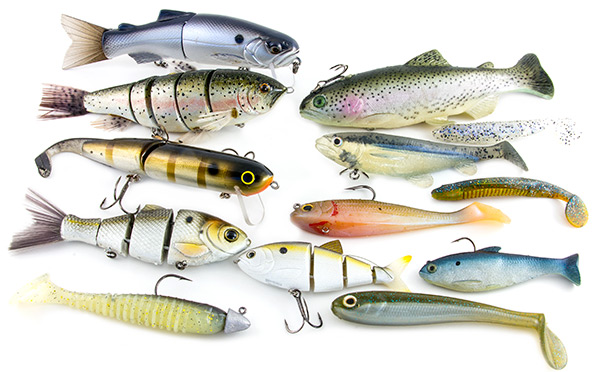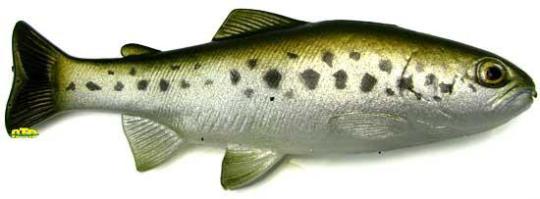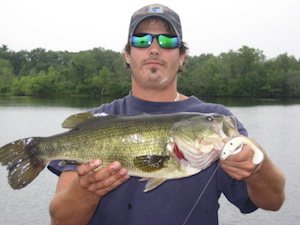Swimbaits are well known for being big bass lures, and they have more than earned that reputation. The bites are mostly few and far between, but when they come they can be from some of the biggest bass in the lake.
When you’re swimbait fishing for bass you need to stay committed to it all day, so you don’t miss those big bites.
Swimbait fishing has become so popular that it has carved out it’s own category in the world of bass fishing. You could literally fill an entire tackle shop with strictly swimbait gear, and get plenty of business.
That’s because so many bass fisherman have become addicted to the monster bass they produce and have equipped themselves with an arsenal of tackle designed to handle these big baits.
Of course they do come in smaller sizes, but nine times out of ten when a bass angler refers to swimbait fishing, they are talking about baits between six and twelve inches long.
Although your more likely to get strikes from trophy bass when fishing a these big baits, that doesn’t mean smaller bass won’t hit them too. Bass will attempt to eat fish of all sizes, even fish the same size as them.
Contents
Types of Swimbaits
There are different types of swimbaits designed to mimic various species that bass prey on. More often than not the designs are made to mimic fish, but some are made to mimic rodents, small waterfowl, and even turtles.
Swimbait designs can be broken down into three categories: hard bodied, soft bodied, and paddle tails. There are subcategories of each type and some come in a combination, like having a hard body with a soft rubber tail. They are typically made of wood, hard plastic, or soft plastic. Here’s a list of the different categories and subcategories before we take a closer look at each one.
- Hard Body
- Multi Jointed
- Single Jointed
- Glide Baits
- Soft Body
- Full Body
- Line Through
- Top Hook
- Paddle Tail
- Hollow Body
- Solid Body
- Full Body
Hard Body Swimbaits
The detail on some of the hard bodied models today can be extremely lifelike, that goes for their action in the water as well. It’s because of this and their large profile that they attract large bass. Due to the amount of work that goes in to the fine tuning of hard swimbaits, they can be very expensive.
It’s not uncommon for serious anglers to pay hundreds of dollars for quality hand-made models. While swimbaits in general lean more on the expensive side, there are much more affordable options.
Typically the hard body models come equipped with treble hooks and are far from weedless. You’ll be able to rip the trebles through light grass but if your fishing in thick weed cover, a hard body is not your best choice. Not to mention these are expensive lures, so you won’t want to get it hung up and lose it.
Some of the hard body versions have a lip in the front of the lure to create the swimming action, much like a crankbait, while others don’t need a lip to swim. The jointed bodies give the bait a better swimming action. They can have one joint in the middle (Single Jointed) or as many as six or more (Multi Jointed). There are some non-jointed versions but not many.
Multi Jointed
These baits are made up of three or more body sections that are all hinged together. They have a wider and smoother swimming action than a single jointed model. In some cases, a certain hard body swimbait model will come in different lengths, and the longer versions will have more joints.
- Best Multi Jointed Models:
Single Jointed
Single jointed swimbaits are made up of two seperate parts, attached to each other by a hinging connection that allows the bait to “swim” as it’s retrieved. Sometimes the hinge is right in the mid section of the bait and other times closer to the tail.
- Best Single Jointed Models:
- Pat’s Perch
- Spro Rat
- Original MS Slammer
Glide Baits
Glide baits are basically an elongated version of a single-jointed hard swimbait. The longer body profile gives the bait a wider “S-shaped” swimming action than that of a standard swimbait. These are great baits if your looking to slow down your presentation, they perform awesome with the stop and go method, similarly to how you work a jerkbait.
- Best Glide Baits:
Soft Swimbaits
These are big, heavy, solid-rubber lures. Their soft bodies give them a more realistic feel when engulfed by a bass, which gives you more time to set the hook. The rubber on the good quality baits is reinforced so it can withstand the wear and tear from fighting fish.
The eyelet for tying your line is usually right at the tip of the nose, but on some models it’s a little further up on the head, making it better for dragging along the bottom. The design features on the different types of soft models can differ quite drastically. Here’s a look at the differences between them.
Full Body
Soft full-body swimbaits are solid rubber baits that use treble hooks attached to the belly, similar to that of a hard swimbait. A lot of these baits do not come equipped with the hooks and you need to buy them separately. The eyelet is connected to the hook rings through the body of the lure.
- Best Full Body Soft Swimbaits
Line Through
Line-through swimbaits are designed to protect the bait from being damaged. They also help to keep a bass hooked during the fight by eliminating the leverage they have when trying to shake off a full-body bait.
To rig them you feed your line through a hole on the nose of the bait, which leads into a narrow tube that goes through the bait and out the bottom or top end. When the line is all the way through you tie a treble hook to it and your rigged. Now when a fish gets hooked, the bait slides up the line during the fight to keep it from getting torn up by the fighting fish.
- Best Line Through Swimbaits
- Savage Gear 3-D Trout
- Jerry Rago BV 3D
- Osprey R-Mac
Top Hook
These baits are equipped with a standard hook, where the long shank of the hook runs through the center of the body and turns up and out the top/back of the lure. Depending on the model, the head of the hook comes weighted or unweighted.
This style has a lot of hook exposure which is great for hooksets, but not very weedless. It’s also the ideal style for dragging along the bottom. Some come with hook ring on the bottom to give you the option of adding a treble hook.
- Best Top Hook Models
Paddle Tail Swimbaits
These are also soft swimbaits, but they are on the smaller side and usually come in packages of multiple baits like soft plastic worms do. They do not come with hooks so you need to get them separately and rig them yourself. These are the ideal style swimbait for fishing heavily weeded areas because they can be rigged weedless.
All of these baits perform the same in the water, it’s the style of hook you choose that affects how the lure will perform. Typically you are choosing between a swimbait hook, a jig head hook, or a straight shank hook. Part of making this decision depends on the body type you plan to fish with.
Hollow Body
Hollow body paddle tail swimbaits are best used with swimbait hooks. These are wide gap hooks that will either have an offset shank or a screw lock to secure the head. They come unweighted or with a “belly weight” that is on the middle part of the hook’s shank. The hollow body on these baits make them softer, so when a fish bites down on them more hook gets exposed, allowing for better hooksets.
- Best Hollow Body Paddle Tails
Solid Body
This version can also be rigged with a swimbait hook, but the solid body gives it a lower hookset success rate. The advantage to the solid body is that it is much more durable and stays rigged properly, and for a longer period of time. These can also be rigged with a straight shank hook or a jig head to be fished like a top hook swimbait.
Best Solid Body Paddle Tails
Swimbait Fishing
The hardest part of fishing big swimbaits for bass is being patient. The action is slow. The bites are going to come far less often than they would with a conventional bass lure and it can be hard not to pick up another rod. But if you want a great shot at a trophy bass then you need to stay committed.
Big bass are smart, and they didn’t get that big without learning a few things along the way, so fooling them isn’t easy and it just doesn’t happen as often. It’s the natural appearance and swimming action of a swimbait that gets these big bass to bite.
How To Fish A Swimbait
In general, most swimbaits are fished similarly to the way you would fish a crankbait, in a straight retrieve. But also like crankbaits, some erratic action to break up the repetitive motion can help entice bites. Big bass look for big meals, especially ones that don’t require a ton of effort to catch. The key is to find the slowest reel speed you can apply to engage the swimming action of the lure.
Of course a lot of how you will be retrieving your bait has a lot to do with whether it sinks or floats. A lot of floating models are best used as a topwater lure, creating the appearance of a dying fish that is floating and slowly swimming along the surface. This is an easy meal that is hard to resist for a hungry bass. Topwater tactics like this are best used in calm water conditions like in early morning or late afternoon.
Alternatively, there are sinking and diving models that you would use deeper in the water column, or even dragged along the bottom. Try to target some kind of cover or structure. Lobbing a big bait along docks or patches of weeds are great methods for getting a bass to ambush your lure.
Luring them out of cover to attack quickly like this does not give the bass much time to investigate the lure. If your fishing them out in open water, a bass will hone in on it from a distance and have time to figure out it’s unnatural.
Choosing Size & Color
Selecting the right size and color are the two most important factors in choosing the best swimbait. The visual appearance plays such a major roll in attracting a basses attention with these lures that using very detailed ones in clear or lightly stained water will give the best results.
That’s why using trout and bluegill swimbaits are so effective in lakes that hold those species. Any time you know the natural prey in the lake your fishing and can match it, you should absolutely do so. If you don’t know what species the bass are preying on then use a baby bass swimbait, I would hope you at least know that bass are present. 😉
Stained water will dull the lures natural colors through the eyes of a bass, so it’s not as crucial as it is in clear water to match local prey. But you should pick brighter versions of the natural prey’s colors so the lure flashes them underwater and attract attention in a familiar fashion. These darker waters are great for fishing swimbaits topwater, creating more noise and attracting attention.
Swimbait Gear
You’re not going to be comfortably throwing these big bass lures with your crankbait rod, or any other freshwater rod you own. Smaller models sure, but once your in to 8″ baits weighing well over an ounce you will need suitable gear. A good reel spooled with adequate line is important, but not at crucial as the rod.
Rods
More than any other lure, it takes a special rod to fish a big swimbait. Rods that are not rated for them are not going to be able to handle them, and will either break or simply not have the “backbone” required to cast them.
Because swimbait fishing has become so popular, almost every rod manufacturer offers a special swimbait rod design. These rods are long, powerful sticks that can launch heavy baits a great distance and set the hook properly. Don’t forget, these bigger bass your targeting have tougher mouths and you need that extra hookset power to get the hooks to puncture their skin.
You need to select the best swimbait rod for the size bait you are fishing. If you plan to throw a wide range of varying weights then you will need more than one rod. For most casual anglers though, a rod rated for 1-5 ounces will suffice.
Reels
There’s only one style reel that will handle these big lures, a baitcasting reel. Any good quality baitcaster will do the job, but most swimbait fisherman usually opt for beefier reels. These reels get put under a lot of wear and tear pulling big baits and fighting heavy fish. A stronger reel will stand the test of time in the big bait game. They are also rated for stronger line.
Line
A minimum of seventeen pound test monofilament line should be used for these heavy lures. Ideally, the line should be in the range of twenty to twenty-five pound test. Some anglers use braid for the extra strength, but the transparentness of monofilament or fluorocarbon is much better since appearing natural is so important.
Since monofilament floats, its better for baits that you plan to work on or near the surface. If your fishing a sinking model, fluorocarbon is better since it sinks. But if your only spooling one reel and fishing shallow and deep then go with mono.












